I see many players making some really BIG forehand groundstroke mistakes and their WHOLE game is suffering as a result.
You can’t make your opponents pay for weak shots and you can’t setup for finishing shots as you otherwise could with a strong forehand groundstroke.
Your forehand needs to be a reliable weapon and if it’s not…it will always be a thorn in your side and you’ll often feel like you lost points and games you could have won if only it were more reliable and powerful.
We’ll cover five of the biggest forehand mistakes we see out on the pickleball courts that may be preventing you from hitting your forehand at your maximum power potential, as well as having optimal control.
So, if you see yourself in any one of these mistakes that we’re about to cover, then that’s definitely something you’re going to want to take a look at and address as needed.
Forehand Mistake #1 – Reach Back On Backswing
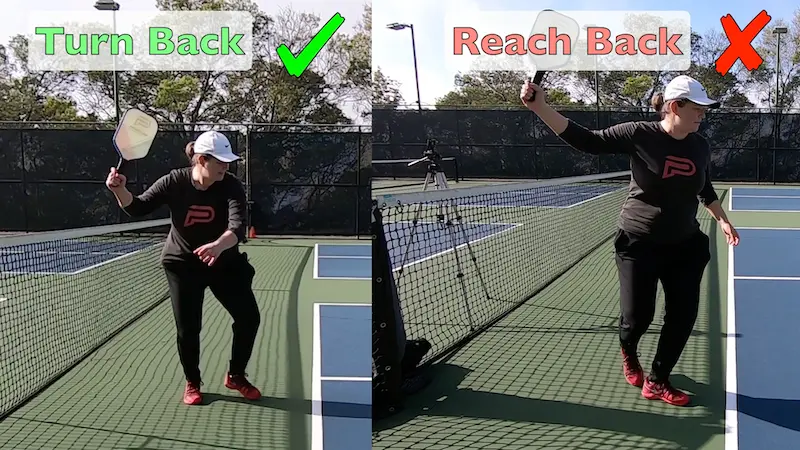
Forehand mistake number one is having a big reach back on your back swing.
Now, you DO need a back swing if you want to hit a forehand with maximum power. But the problem comes into play when you do a big reach back with your arm versus a turn back.
Forehand Turn Back vs. Reach Back
With a large reach back, you’re not fully turned to the side and therefore you body is not coiled up correctly. So, you’re mostly going to be generating power into the shot with your arm.
This is not ideal because you’re not going to be able to use your body to rotate into the shot. Since you’re not coiled up correctly, there’s nothing to uncoil so you end up just arming it which is not going to produce the maximum power you otherwise could. You’re leaving a lot of power potential on the table this way.
With a turn back, your take back for your backswing is mostly achieved by the hip turn and shoulder turn. There’s really not a whole lot of reach back from the arm. There is a little bit of a setback with your arm and your paddle but it’s a lot less than most people realize.
To the untrained eye, it’s deceiving and it looks like a big backswing when in fact it’s more of a turn back rather than a reach back.
So, to be clear, having a more pronounced backswing is not wrong. In fact, you need it. It’s really just about how you’re achieving that backswing.
How it’s achieved makes all the difference. For maximum power potential your hips should be coiled up and your shoulders should be well turned and coiled as well. Your legs should be loaded up with a knee bend.
You can then use the ground to unwind into that shot starting with a push off with the back foot.
You can ultimately hit it much harder because you can speed up the unwind using your whole body in an efficient unwinding sequence. Starting from the legs, then going to the hips, then the shoulders which ultimately whips the arm around and through and into the finish.
If you attempt to speed up your forehand out of a reach back backswing then things are going to start to go astray very quickly.
You will lose control at higher speeds. At lower speeds you do have some control which is why we do see this mistake happening quite a bit. But the minute you try to speed it up and have more power in your shot, you’re going to start running into problems.
You will have more control, at both lower and higher speeds, with a turn back backswing rather than a reach back backswing .
Forehand Mistake #2 – Late Contact
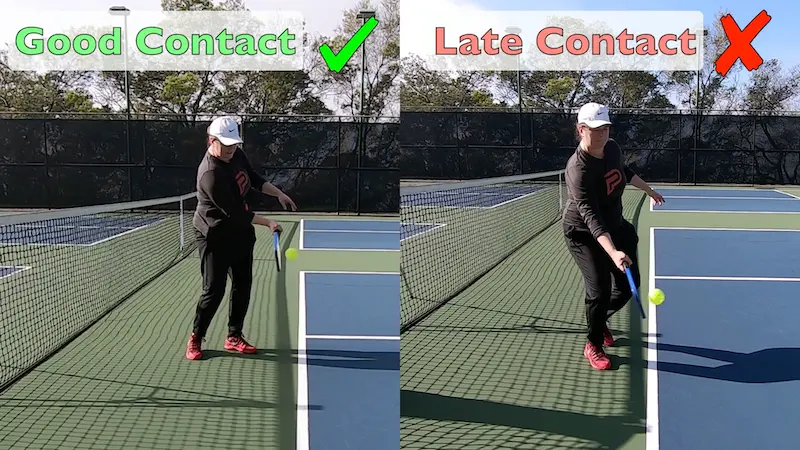
Forehand mistake number two is having a late contact.
Now, this is just a notorious problem in pickleball. I unfortunately see this happening all the time. It’s a power killer as well as a control killer.
It’s really hard on your body and you’re going to maybe have some elbow and shoulder trouble as a result because you’re just jamming up your joints and muscles when you have late contact.
I often see this in combination with mistake number one. Someone might have a big reach back, and then they’re coming into contact, and they hit it late, kind of beside them. Those often come together but not always.
I do see, in many instances, where there’s late contact without a big reach back so it is a standalone problem as well.
Now let’s break down why this is so problematic in a way that’s maybe a little simpler to understand.
Let’s bring it into an everyday type of situation.
Let’s imagine you were pushing a heavy object with just one arm because the forehand swing is just with one arm. You would push it with your body mostly lined up behind the object right? Maybe you’d be ever so slightly off to the side, because your arm is to the side of your body, but mainly you’ll try to keep it front of you as much as possible.
You’re not going to do it where you’re reaching a lot to the side and your body is not behind it because that’s a much weaker position. You can’t get your whole body weight into the push.
You’re really pushing it with some very small muscles in your arm. That’s a problem!
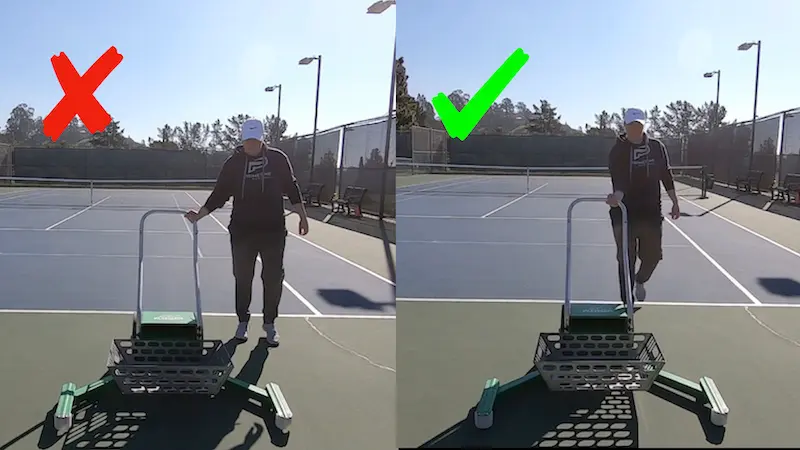
If you have a late contact on your forehand like this then your power is going to suffer dramatically as well as your control and your body. We want to stay injury-free so let’s get that contact out in front so we can maximize our play out there in more ways than one.
Forehand Mistake #3 – Last Second Preparation or Rushed Preparation
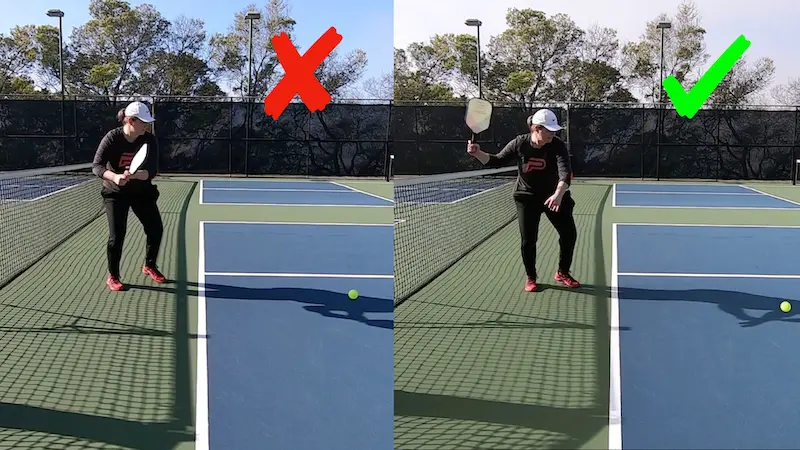
Forehand mistake number three is a last second preparation or a rushed preparation.
You don’t want to be so early that you stop in the back part of your swing and are waiting for the ball.
But, you also don’t want to be so late that you’re making a very rushed backswing as you enter into contact.
As I mentioned previously, you want to be initiating your shot with a shoulder turn. You’re going to be initiating that turn as soon as you start moving your feet and when you recognize where the ball is going.
You’re going to start tracking it over your non-dominant shoulder rather than still having your chest facing forwards to the court as the ball is about to be bouncing.
If you aren’t doing all of that early enough then you will experience a late preparation or rushed preparation error. You then limit the use of your body.
It always comes back to that… you don’t want to be limiting the use of your body.
If you’re limiting the use of your body you’re limiting the potential of your power. You’re also increasing your risk of having a late contact when you’re rushed.
And again, just like previous mistakes, you’re relying far too heavily on your arm during the shot if you’re waiting to do most of your backswing right as the ball is about to bounce. Then, you’re really letting the ball play you rather than you playing the ball.
On well-timed shots a lot more of the shot prep should already take place before the ball bounces. In fact, you should initiate the shoulder turn, which is the start of the preparation, almost as soon as you have recognition of which side the ball is coming to.
Forehand Mistake # 4 – No “C” Motion
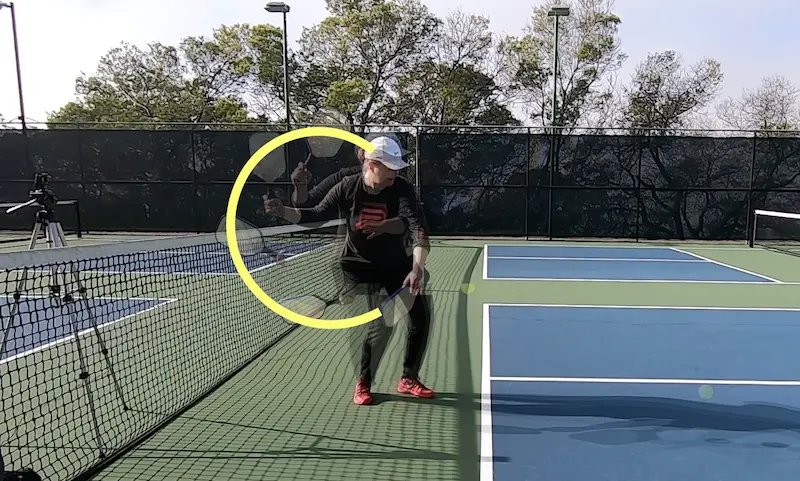
Forehand mistake number four is not having a “C” motion in the early part of your swing.
One of the things I often see is players going straight back and then straight forward. They have a stop in the back part of their swing before heading back forward so this creates a hitch in the swing.
You can’t build up momentum this way, your rhythm breaks down and there’s just no fluidity to the shot.
The correct motion is to have the paddle tip up as you make your turn back and then you let the paddle head drop down and under your wrist and the ball. This allows for good momentum build up as you head into contact.
We often talk about a low to high motion on the ground stroke, on both the forehand and the backhand side. But, it’s really turn high, then drop (that’s the low part), head into contact and then finish high and around. So it’s high…low…high for the most part.
Choppy shots, with a hitch in them, such as when you go straight back before coming forward, lead to a loss of power and consistency.
I see a stop in the motion happening in different ways but this straight back and straight forward action is one of the bigger offenders that leads to a hitch in your stroke.
Forehand Mistake # 5 – Not Enough Shoulder Turn
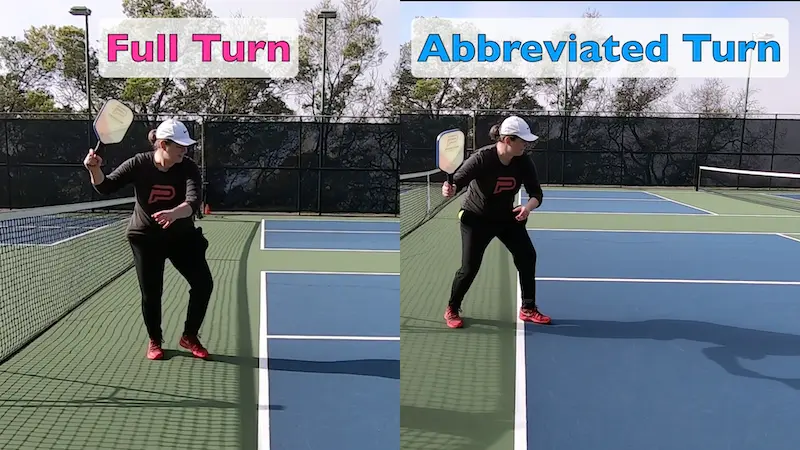
Mistake number five is not having enough turn on your back swing on the forehand.
This mistake is a bit unique because it’s situational.
In certain situations you’re not going to want to have a complete turn. But, if that’s your default go to and you never get a complete turn on any forehand, chances are that’s definitely a mistake.
There are many times when you want to hit with tremendous power to try to get the ball by someone or overwhelm them with power such as when you’ve received a short sitter. You do want to have a complete turn in that instance to maximize your power.
However, at times, if you have to run forward to the shot and are reaching for it then you are going to have less of a pronounced turn and backswing.
Or, if you’re taking the ball on the rise because it’s bouncing near the baseline near your feet, again, you’re not going to have a complete turn. You’re going to have a more compact backswing, bit less of a turn, and deal with it that way.
Also, when you’re returning you may have time for a total wind-up on your return but you may not want to do that because you’re taking some pace off the shot. You’re just going to send it back deep so that you have time to run in behind it. You’re going to send it back with a bit more loft and not at top or even high speed. Maybe a 5 to 7 out of 10 on a speed scale. So, in that case, you’re also going to use a more abbreviated backswing.
So, this one is not a mistake in all situations. It’s situational.
But again, if you are never getting a complete turn on any forehand ever, then you’re going to want to take a look at that because there definitely are times when you want to get max power on your shot. In those instances you are going to want to have a nice strong turn on your forehand.
Final Thoughts
If your forehand is weak and wobbly then chances are that one or more of the mistakes we’ve outlined here could be the culprit.
Take a look at your forehand on video, see which one (ore more) of these mistakes apply to you and get to work on fixing it one by one. Having a strong forehand makes a world of difference in how much fun you have out there and how much you end up winning.